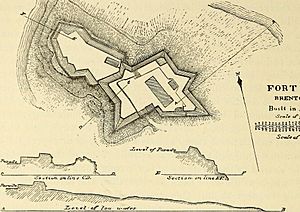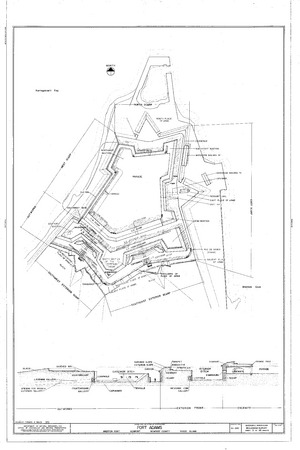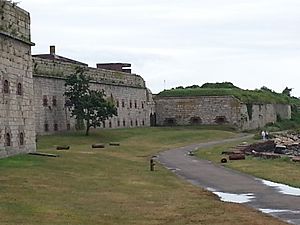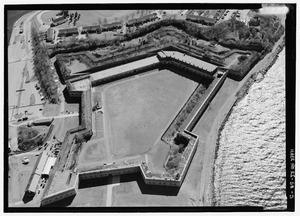Fort Adams facts for kids
Quick facts for kids Fort Adams |
|
|---|---|
| Newport, Rhode Island | |
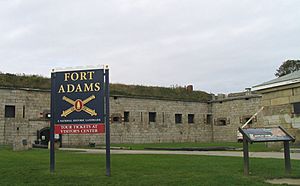
Fort Adams on 31 August 2005
|
|
| Type | Coastal artillery post |
| Site information | |
| Controlled by | United States |
| Site history | |
| Built | 1798–1799; 1824–1857 |
| In use | 1799–1824; 1841–1953 |
| Materials | granite, shale and brick |
| Garrison information | |
| Past commanders |
Captain John Henry Lieutenant Colonel Benjamin Kendrick Pierce Brigadier General Robert Anderson Colonel Henry Jackson Hunt |
|
Fort Adams
|
|
| Nearest city | Newport, Rhode Island |
| Built | 1799, rebuilt 1824 |
| Architect | Louis de Tousard (1799), Simon Bernard and Joseph G. Totten (1824) |
| NRHP reference No. | 70000014 |
| Significant dates | |
| Added to NRHP | July 28, 1970 |
| Designated NHLD | December 8, 1976 |
Fort Adams is an old United States Army base in Newport, Rhode Island. It was first built on July 4, 1799. The fort was named after President John Adams, who was in charge at that time. Its main job was to protect the coast.
The first leader of the fort was Captain John Henry. He later played a part in starting the War of 1812. The Fort Adams you see today was built between 1824 and 1857. It is now part of Fort Adams State Park.
Contents
History of Fort Adams
The first Fort Adams was designed by Major Louis de Tousard. He was an engineer for the United States Army Corps of Engineers. This fort was part of the first system of defenses for the U.S. coast.
After some changes in 1809, this fort had 17 cannons. Soldiers from Rhode Island protected it during the War of 1812. A report from 1811 described it as a star-shaped fort made of stone. It had wooden and brick buildings for one company of soldiers.
Building the New Fort
After the War of 1812, leaders decided the U.S. needed stronger forts. They chose to replace the old Fort Adams with a much bigger one. This new fort was designed by Brigadier General Simon Bernard. He was a French engineer who worked for Napoleon Bonaparte.
Bernard designed the new Fort Adams in a classic style. It became one of the most complex forts in the Western Hemisphere. It had many layers of defense to stop attackers. It also had a separate small fort, called a redoubt, about 650 yards south. Only Fort Monroe in Virginia and Fort Jefferson in Florida are similar in size.
Construction of this new fort started in 1824. First lieutenant Andrew Talcott began the work. From 1825 to 1838, Lieutenant Colonel Joseph Gilbert Totten oversaw the building. He was a very important American military engineer.
Fort Adams in Action (Sort Of)
The new Fort Adams first had soldiers in August 1841. It was an active U.S. Army base until 1950. During this time, the fort was involved in five major wars. These included the Mexican–American War, American Civil War, Spanish–American War, World War I, and World War II.
Even though it was active, the fort never actually fired its guns in a real battle. It was always ready, but never needed to defend itself.
At the start of the Mexican–American War in 1846, Benjamin Kendrick Pierce led the fort. He was the brother of President Franklin Pierce. The fort's redoubt, a small defensive outpost, was built during this war.
From 1848 to 1853, Colonel William Gates commanded Fort Adams. He was a veteran of two wars. Many of his soldiers later died in a shipwreck in the North Atlantic Ocean in 1853.
In 1854, Fort Adams had many cannons. It had 100 large 32-pounder guns and 57 24-pounder guns. It also had 43 24-pounder howitzers. These were all smoothbore cannons. The howitzers were short guns used to protect the fort from attacks on land.
Civil War Years
During the American Civil War, the United States Department of War worried about Maryland's loyalty. So, the United States Naval Academy moved from Annapolis, Maryland, to Fort Adams in 1861. It later moved to a hotel in Newport and stayed there for the rest of the war.
Many famous people studied at the Naval Academy while it was at Fort Adams. One was Robley D. Evans. He later commanded the battleship USS Iowa in the Spanish–American War. He also led the Great White Fleet on its first trip around the world.
In 1862, Fort Adams became a training center for the U.S. Army's 15th Infantry Regiment. New soldiers came here to train.
From August to October 1863, Brigadier General Robert Anderson led Fort Adams. He was famous for commanding Fort Sumter. That fort was attacked in 1861, which started the Civil War.
Fort Upgrades in the 1870s
In the 1870s, Fort Adams got new, more modern weapons. It received eleven 15-inch Rodman guns and thirteen 10-inch Rodman guns. It also got four 6.4-inch Parrott rifles. New places were built for the largest guns.
Older weapons were removed, except for 20 32-pounder guns. For defense on land, the fort received smaller, mobile cannons. In 1894, four 8-inch converted rifles were added in a new battery south of the fort.
Fort Adams in the 20th Century
As technology changed, the fort's weapons were updated. In the 19th century, it used cannons loaded from the front. In the early 20th century, it got modern, rifled cannons loaded from the back. During and after World War II, it even had anti-aircraft guns.
New batteries (groups of guns) were added south of the main fort. These were built between 1896 and 1907. They helped defend the East Passage of Narragansett Bay. They worked with Fort Wetherill in Jamestown.
Endicott Period Batteries
Here are some of the batteries built at Fort Adams during this time:
| Name | Number of Guns | Gun Type | Years Active |
|---|---|---|---|
| Greene-Edgerton | 16 | 12-inch coast defense mortar | 1898–1942 |
| Reilly | 2 | 10-inch gun M1888 | 1899–1917 |
| Talbot | 2 | 4.72-inch Armstrong gun | 1899–1919 |
| unnamed | 1 | 8-inch gun M1888 | 1898–1899? |
| Bankhead | 3 | 6-inch Armstrong gun | 1907–1913 |
| Belton | 2 | 3-inch gun M1903 | 1907–1925 |
Batteries Greene-Edgerton, Reilly, and Talbot were finished first, between 1896 and 1899. Battery Greene-Edgerton had sixteen mortars. Battery Talbot had two 4.72-inch Armstrong guns. One of these guns is now a memorial in Newport, Rhode Island. In 1907, Battery Bankhead and Battery Belton were completed.
These batteries were named after important military figures. For example, Battery Greene-Edgerton was named for Major General Nathanael Greene from the American Revolutionary War. Battery Reilly was named for Captain Henry J. Reilly, who died in China.
In 1913, Battery Bankhead's guns were sent to Hawaii.
World War I Role
The United States joined World War I in April 1917. Fort Adams became a main base for the Coast Defenses of Narragansett Bay. It was also a training center for soldiers. The United States Army Coast Artillery Corps (CAC) was in charge of all heavy artillery.
Four heavy artillery regiments and two brigade headquarters were formed at Fort Adams. They served in France. These included units that used French-made railway guns. Thornton Wilder, a famous author, served at Fort Adams during World War I. He later wrote a novel inspired by his time there.
In 1917, two 10-inch guns from Battery Reilly were removed. They were meant to be used as railway guns. Eight of the sixteen mortars at Battery Greene-Edgerton were also removed in 1918. This was done to make reloading faster.
World War I ended on November 11, 1918. After the war, Battery Talbot's guns were removed in 1919. They became memorials in Newport and Westerly. Later, anti-aircraft guns were placed at the fort.
World War II Role
During World War II, over 3,000 soldiers were stationed in the Harbor Defenses of Narragansett Bay. In September 1940, the 243rd Coast Artillery Regiment joined the 10th Coast Artillery Regiment at Fort Adams.
The United States entered the war on December 7, 1941. During the war, Fort Adams and most older forts were replaced by new defenses. These new defenses were at Fort Church and Fort Greene. The old guns at Fort Adams were removed.
However, new anti-aircraft guns were installed at Fort Adams. These included 90-millimeter guns and 40 mm Bofors guns. There were also .50-caliber machine guns. By December 1943, an Anti-Motor Torpedo Boat Battery was also at Fort Adams. By the end of the war in August 1945, the number of soldiers at the fort was reduced.
Fort Adams State Park Today
In 1953, the U.S. Army gave Fort Adams to the U.S. Navy. The Navy still uses some of the land for housing today. President Dwight D. Eisenhower stayed at the former commanding officer's house. This house is now called the Eisenhower House. He vacationed there in 1958 and 1960.
From the 1950s to the 1970s, Fort Adams was not well cared for. It suffered from weather damage and vandalism. In 1965, the fort and most of its land were given to the State of Rhode Island. It became Fort Adams State Park.
In 1976, Fort Adams was named a National Historic Landmark. This was because of its unique military design. In the 1970s, the fort was cleaned up and opened for tours. It was also used for filming a TV show called The Scarlet Letter.
Since 1981, the Fort Adams grounds have hosted the Newport Jazz Festival and the Newport Folk Festival. These are popular music events.
In the early 1990s, a program cleaned up the fort to make it safe for visitors. In 1994, the Fort Adams Trust was created. This group gives guided tours and works to restore the fort. They started tours in 1995. Since then, many parts of the fort have been restored. The trust continues its restoration work today.
In 2012, the park was the official place for the America's Cup World Series in Newport.
Famous People Connected to Fort Adams
Many important people have been associated with Fort Adams:
- Robert Anderson – A Civil War general who commanded Fort Sumter.
- John G. Barnard – An Army engineer and Civil War general.
- Alexander Dallas Bache – An Army engineer and superintendent of the United States Coast Survey.
- Pierre G. T. Beauregard – A Confederate Civil War general.
- Simon Bernard – A French general and engineer who designed the new Fort Adams.
- Ambrose Burnside – A Civil War general, Governor of Rhode Island, and U.S. Senator.
- Fox Conner – An important officer in World War I and a mentor to President Dwight Eisenhower.
- George W. Cullum – A Civil War general.
- Henry A. du Pont – A Medal of Honor winner and U.S. Senator.
- Dwight Eisenhower – Vacationed at Fort Adams when he was president.
- Robley D. Evans – A Navy admiral who commanded the Great White Fleet.
- William Gates – A long-serving Army officer.
- John Henry – The first commander of Fort Adams.
- Henry Jackson Hunt – A Civil War general and artillery commander at the Battle of Gettysburg.
- Lyman Lemnitzer – An Army general and Chairman of the Joint Chiefs of Staff.
- John B. Magruder – A Confederate Civil War general.
- Franklin Pierce – A general, Senator, and President of the United States.
- William S. Rosecrans – A Civil War general.
- Joseph G. Totten – The Chief Engineer of the U.S. Army who oversaw Fort Adams' construction.
- Louis de Tousard – A Revolutionary War hero who designed the first Fort Adams.
- Thornton Wilder – A famous author whose book Theophilus North was inspired by his time at Fort Adams.
- William Griffith Wilson – Known as "Bill W.", a founder of Alcoholics Anonymous. He was stationed at Fort Adams during World War I.
Images for kids
See also


